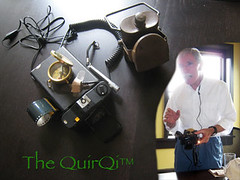We are joyous to announce the birth of Vaughn Summers — the 8 pound 10 ounce son of our Office Manager Lauren Summers and her husband Dusty. We believe that Vaughn is just about the cutest baby we have ever seen!

We have been silent for a few weeks as we were preparing for a major demonstration of our technology (it went very well). With a few days off after the push, I went to Vermont to enjoy a fall weekend.
New England had the best foliage in years! While I was there, I went to PUB — a Friday night gathering of friends in Manchester, Vermont — where we do all sorts of fun things — including carving pumpkins. This Qi Jack-o-Lantern will be added to others in Bennington, Vermont to see if they can set a record.

Check it out!
 Posted in All | Comments Off on Happy Exbiblio Halloween | Other posts by Ruth
Posted in All | Comments Off on Happy Exbiblio Halloween | Other posts by Ruth

For the last hundred years, Earth has experienced a rapid loss of forested area. Reports continue to indicate huge forests losses.
Almost half of the planet’s original forest has been destroyed, mostly during the last three decades. Between 1990 and 1995, the net forest loss equaled 33 football fields per minute (112 600 square kilometers annually).
About 47 percent of the world’s forests occur in the tropical zone, 9 percent in the subtropics, 11 percent in the temperate zone and 33 percent in the boreal zone. In the tropics, about half of the mature forests, between 750 to 800 million hectares of the original 1.5 to 1.6 billion hectares, have been felled. Between 1990 and 2000 alone, natural forests in the tropics disappeared at an annual rate of fourteen million hectares, a rate of loss of an acre a second. Between 1960 and 1990, about 20 percent of total tropical forest cover was lost. Read the rest of this entry »
 As the unabashedly analog guy in this resolutely digital company (heck, I used to be a banker before I became an honest business man!), I simultaneously marvel and despair at encounters with cutting-edge technology: How do software and hardware engineers do that stuff, and why can’t I? OK, so I’m pretty good now with my digital camera, and just succumbed to the siren song of Apple and bought an iPhone. But I still use a 70-year old fountain pen, a 50-year old Leica, and have a funky leather saddle (Brooks, of course) on my titanium road bike.
As the unabashedly analog guy in this resolutely digital company (heck, I used to be a banker before I became an honest business man!), I simultaneously marvel and despair at encounters with cutting-edge technology: How do software and hardware engineers do that stuff, and why can’t I? OK, so I’m pretty good now with my digital camera, and just succumbed to the siren song of Apple and bought an iPhone. But I still use a 70-year old fountain pen, a 50-year old Leica, and have a funky leather saddle (Brooks, of course) on my titanium road bike.
Read the rest of this entry »
 Posted in All | Comments Off on QuirQi: my analog solution to digital challenge | Other posts by Bill
Posted in All | Comments Off on QuirQi: my analog solution to digital challenge | Other posts by Bill
In the conventional, “textbook” way of doing things, early-stage companies secure initial funding from “friends and family members” or angel investors, then through crisp and timely execution of a well-articulated business plan graduate to a stage of development, and level of sophistication where they are able to attract investment from venture capital firms. The company typically would be formed as a “C” corporation, would recruit a CFO or VP Finance to generate all the projections/spreadsheets and implement all the operational controls that VC’s expect, engage legal counsel to pull together the standard set of documents for a Series A funding round with the standard set of preferences, etc., etc. The company is then set on a standard three to five year trajectory towards either an initial public offering, or as a candidate for acquisition by a large, publicly traded technology or web services company. All bog standard, all terribly predictable and all terribly…uninteresting. But oh! so tempting to head down that well-trodden path as the lowest-friction, least risky way to bring a new idea to fruition.
But, what happens when the core idea of the company itself – how it should be structured, how it should behave in society, what it’s financial and human/social objectives are – is largely at odds with these conventions? Should the founders, board members and staff opt to head down the well-trodden “conventional” path and hope to preserve at least some of the core values and objectives of the company? Or take a chance in pioneering a new way of building a company; one that combines a resolutely for-profit technology business with a deep commitment to social issues? Read the rest of this entry »
Quentin Stafford-Fraser (introduced earlier) recently spoke at the 2007 GOVIS conference.
His first talk, ‘Changing the Face of the PC’, tells the story of the creation of Ndiyo, DisplayLink, and Cambridge Visual Networks, the technologies and motivations behind them, and some thoughts about the future.
Quentin and Martin King are founders of DisplayLink (formerly Newnham Research) as well as Exbiblio.
The second talk was focused on Exbiblio—our vision, technology, company, values, and more. Please have a look, to see who we are, what we are doing, and how we intend to do it:
View on Google Video
Videos to download: (right-click to save to disk):
For iPod (71 MB)
High-quality MP4 (162 MB)

This work is licensed under a Creative Commons Attribution-Noncommercial-No Derivative Works 3.0 License.
 Posted in All | Comments Off on The Paper Renaissance | Other posts by Claes-Fredrik
Posted in All | Comments Off on The Paper Renaissance | Other posts by Claes-Fredrik
 We’ve been having trouble getting the image sensor data through to the main memory on the Rosencrantz form factor board, but today, Oscar, from Synapse, figured it out.
We’ve been having trouble getting the image sensor data through to the main memory on the Rosencrantz form factor board, but today, Oscar, from Synapse, figured it out.
Getting the image processing unit (IPU) configuration right in the iMX31 has been a difficult task, and as of yesterday, we were getting images through, but only half an image frame’s worth of data per frame. Today, Oscar triumphantly sent us a picture of a gnome taken with the form factor board.
This takes a major concern off our shoulders.
 Posted in All | Comments Off on Rosencrantz Image Sensor Driver | Other posts by Claes-Fredrik
Posted in All | Comments Off on Rosencrantz Image Sensor Driver | Other posts by Claes-Fredrik
The “oPen™” name was originally assigned by the development team as a project name for our interactive, handheld scanning tool. Although the name oPen is certainly a clever double-entendre, it was never intended to be the name of the commercial device. In that capacity the name has a couple of major problems.
Calling it a pen plops it into a mundane category of existing products that embody only a small amount of our functionality. These handheld scanners (e.g. C-Pen, IrisPen, DocuPen, etc.) have a reputation for producing a frustrating and limited user experience. With all of that established baggage already out there, oPen may as well be shmoPen. Who will notice? Read the rest of this entry »
Recently the New York Times released a poll that it conducted with CBS News. In that poll, 90% of Democrats, 80% of Independents, and 60% of Republicans all said that immediate action was required to curb the warming of the atmosphere and deal with climate change impacts. Only 1% said no steps were needed.
This poll, if representative of America, would suggest that we have arrived at a place of awakening. In part this is a relief. It is a relief that we no longer have to explain the science and numbers surrounding climate change to the masses. The public has become informed, and now there is a need for solutions. Read the rest of this entry »
 Posted in All | Comments Off on The Awakening | Other posts by Hilary
Posted in All | Comments Off on The Awakening | Other posts by Hilary
The past few weeks have seen huge updates in the Rosencrantz HW land. The project is clearly starting to come together. A few of the different components are now working, and it’s become easier to visualize what else we need to get working, and how we will get there.
There’s a magical thing that happens when you are building digital hardware, where the hardware grows up from a series of loosely connected circuits (that don’t tend to be functioning in any way) to a cohesive unit, working together to accomplish the task we put in front of it. The hardware can’t work as a unit until its sub components not only achieve self awareness (they know how to work themselves, usually requiring firmware), but they also start to have a small amount of awareness of others (they know how to interact with the other components in the system). Seeing your project grow up is very exciting, and it’s not that far fetched for engineers to see themselves as parents of their projects, both excited and slightly nervous to let them out in the world to live their own lives and leave their own marks (we all know about the iPod™, but who among us can talk about the engineers who designed it – no the iPod left its own mark on the world, a mark independent of the people who created it). Read the rest of this entry »











